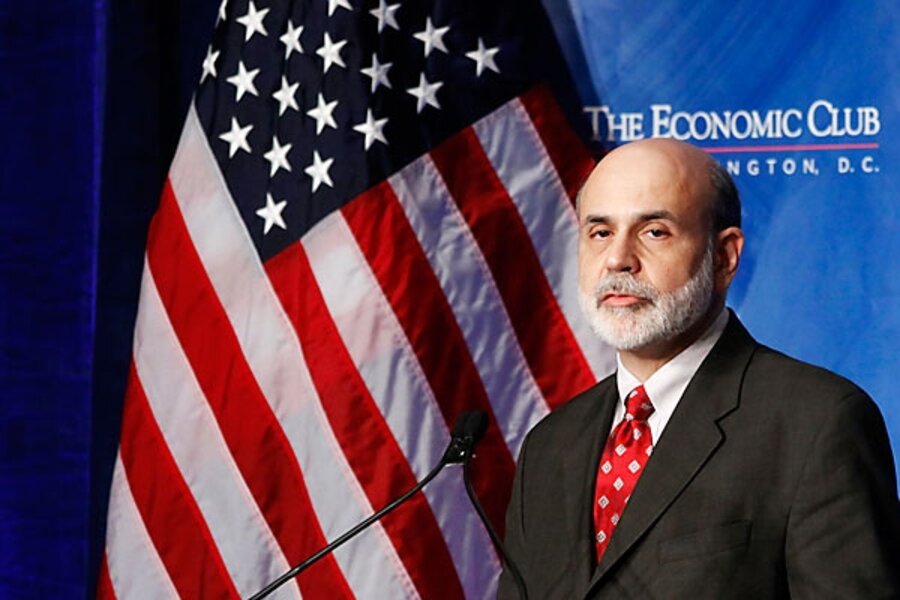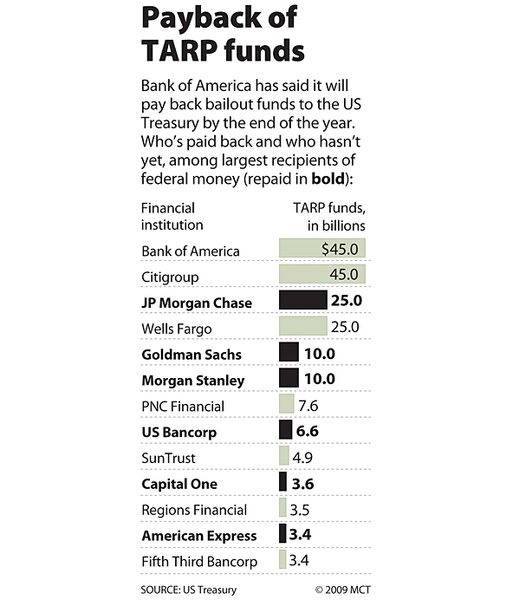Bernanke speech: financial stability is returning
Loading...
It's welcome news for US taxpayers: The cost of the great bailouts of 2008 is coming in smaller than some forecasters had predicted.
Exhibit A this week is the financial rescue program called TARP – the $700 billion Troubled Asset Relief Fund. The money paid out in loans or investments to banks and other corporations is being paid back faster than expected, the Obama administration says. Although the US Treasury still expects a loss rather than a profit from the program, it now predicts that the 10-year cost will be no more than $141 billion, which would be $200 billion less than the administration predicted as recently as August.
The TARP turnaround is part of a broader trend. In some other areas of government, too, massive rescue programs are winding down as the storm clouds of financial crisis fade. Since March, the Federal Reserve has been able to downsize its support programs for investment banks, short-term business credit, and the insurance firm AIG.
"All told, the Federal Reserve's actions – in combination with those of other policymakers here and abroad – have helped restore financial stability and pull the economy back from the brink," Fed Chairman Ben Bernanke said in a speech Monday.
Two positives
That's positive in two ways. First, the programs have been successful in steering the economy out of a free-fall. Second, the direct cost of the bailouts to taxpayers appears to be coming well below the trillion-dollar estimates that some made earlier this year.
But it doesn't mean that the economy or taxpayers are totally off the hook.
With the unemployment rate at 10 percent, the economy is hardly back to normal. And even if the bailouts aren't as costly as feared, the tough economic times are affecting government finances in other ways. Falling tax revenues and the $787 billion stimulus program are pushing the federal deficit to a record level.
Moreover, President Obama and congressional Democrats are talking about using some of the "saved" TARP money to pay for new spending to create jobs.
Proponents say that will help ensure that an economic recovery takes hold. Critics worry that such stimulus efforts are ineffective and add to the US debt that taxpayers will have to pay.
A number of large financial firms, including American Express and Goldman Sachs, have already repaid TARP money. Last week, Bank of America announced that it would repay one of the largest investments the TARP fund has made: $45 billion.
The bank issued new stock shares, allowing it to repay the government while also maintaining what regulators see as a safe level of capital on hand.
Other costs of the financial crisis
Even as the TARP picture brightens, the financial crisis is costing Americans in other ways:
• The Federal Deposit Insurance Corp. is struggling to collect enough money from healthy banks to pay for ongoing bank failures.
• The Federal Reserve is maintaining ultralow short-term interest rates – a policy that helps banks but means lower returns for fixed-income investors such as retirees.
• The Fed has also been buying mortgage-backed securities, in an effort to help the housing market by keeping mortgage interest rates low. This creates the risk that mortgage rates could rise – and home prices fall – when the Fed backs off from its prop-up program.
• America is grappling with much higher unemployment because of the crisis, which caused a sharp tightening of credit for small businesses and consumers.
-----
Follow us on Twitter.






